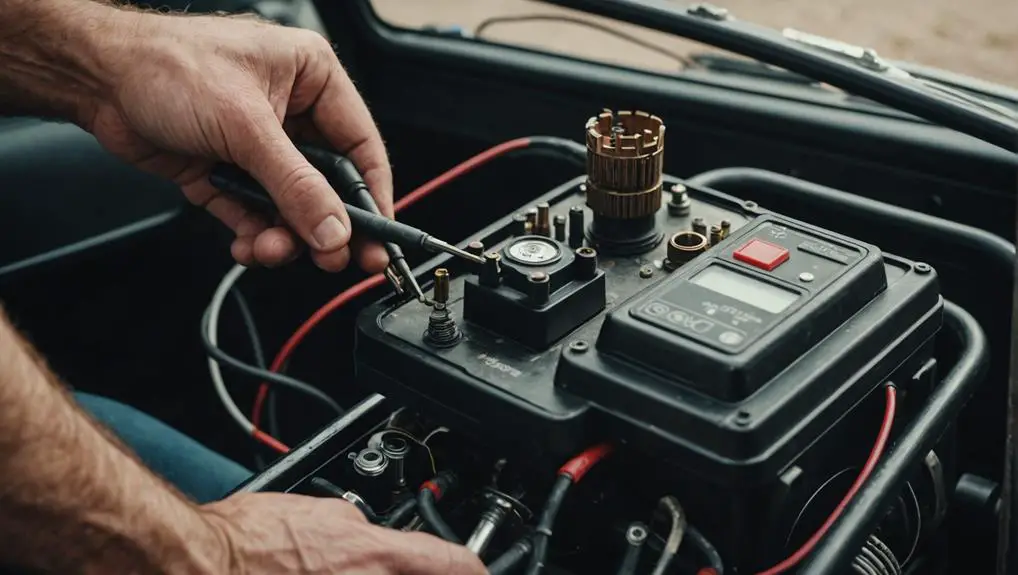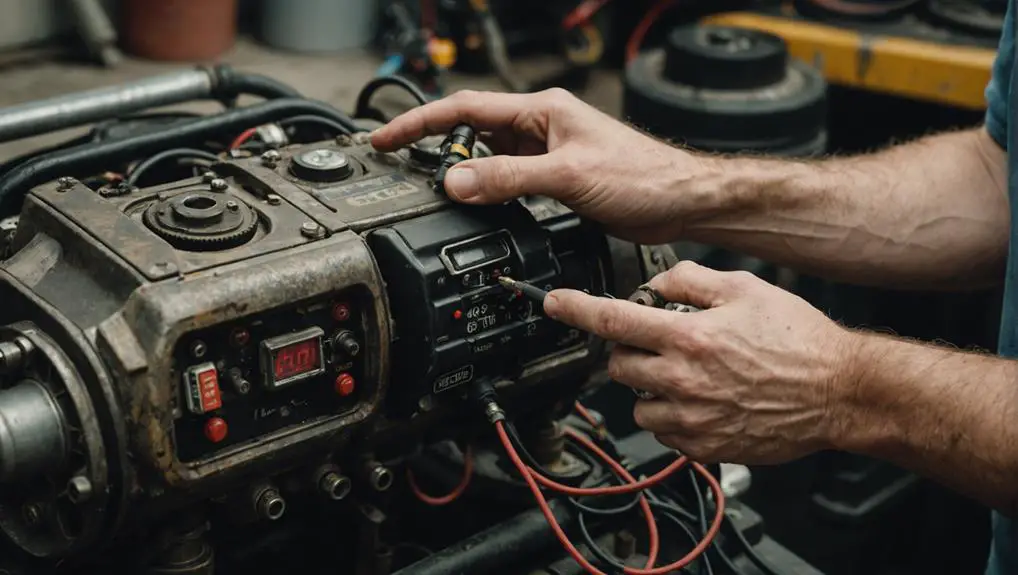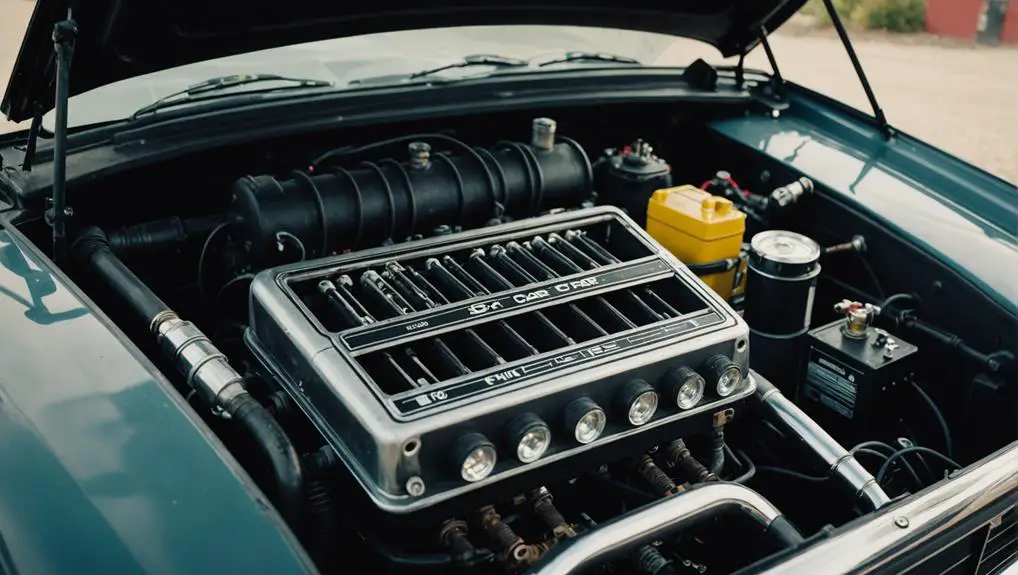When your gas Club Car won't start, it can be frustrating, but you can often pinpoint the issue by following a systematic approach. Start by checking the battery voltage and inspecting for corrosion at the terminals. If that checks out, you'll want to move on to the fuel system and ignition components. Each step reveals potential culprits that could be holding you back from a smooth ride. Are you ready to uncover what might be causing your starting troubles?
Key Takeaways
- Check the battery voltage; it should be between 12.6 and 12.8 volts for optimal performance.
- Inspect battery terminals for corrosion and ensure all connections are tight and secure.
- Verify there is sufficient fuel in the tank; add fresh gasoline if levels are low.
- Examine the starter motor for visible damage and ensure it receives proper voltage during ignition.
- Inspect spark plugs for wear or carbon buildup, replacing them as necessary for efficient ignition.
Common Symptoms of Starting Issues
When your gas Club Car won't start, you'll likely notice a few common symptoms that can help pinpoint the problem.
First, listen for unusual sounds when you turn the key. A clicking noise may indicate a weak starter or solenoid issue, while a grinding sound suggests a malfunctioning starter gear. If the engine cranks slowly or not at all, this often points to electrical issues beyond the battery, like corroded connections or faulty ignition components.
Next, check the dashboard. If warning lights illuminate, it could indicate a problem with the fuel system or engine sensors. Additionally, observe the fuel gauge; an empty tank can prevent starting, and fuel contamination can also lead to starting issues.
Another symptom is the presence of fuel odor, signaling a possible leak or fuel line issue.
Checking the Battery
To troubleshoot starting issues, you need to check the battery's voltage and guarantee it's within the ideal range, typically around 12.6 volts.
Next, inspect the terminal connections for corrosion or looseness, which can prevent proper electrical flow.
Addressing these points can greatly improve your Club Car's starting performance.
Battery Voltage Assessment
Evaluating battery voltage is essential for diagnosing starting issues in a gas Club Car. Start by using a digital multimeter to measure the battery voltage. Set the multimeter to the DC voltage setting and connect the red lead to the positive terminal and the black lead to the negative terminal. A fully charged battery should read between 12.6 and 12.8 volts.
If you get a reading below 12.4 volts, the battery is undercharged and may need recharging or replacement.
Next, try to start the cart while monitoring the voltage. If the voltage drops considerably below 10 volts during cranking, it indicates a weak battery or internal resistance. In this case, you should consider testing individual cells within the battery, as one failing cell can affect overall performance.
Terminal Connections Inspection
After verifying the battery voltage is adequate, the next step is to inspect the terminal connections.
Start by turning off the ignition and removing the key to guarantee safety. Then, visually check the battery terminals for any corrosion, which appears as a white, powdery substance. Corrosion can impede electrical flow and cause starting issues.
Next, use a wrench to carefully loosen the terminal clamps. Remove the negative (-) terminal first to prevent any short circuits, followed by the positive (+) terminal. Inspect the clamps for damage or wear; they should fit snugly without excessive play.
If you find corrosion, clean the terminals with a mixture of baking soda and water and a wire brush. Make sure to wear gloves and safety goggles during this process.
Once cleaned, reconnect the positive terminal first, followed by the negative. Verify both connections are tight, but avoid over-tightening, which can damage the battery posts.
Inspecting the Ignition System

A reliable ignition system is essential for guaranteeing your gas Club Car starts smoothly and operates efficiently.
Begin by checking the ignition switch. Confirm it's functioning correctly and isn't worn out or damaged. If the switch feels loose or doesn't click properly, replacing it might be necessary.
Next, inspect the spark plug. Remove it and examine its condition. A worn or fouled spark plug can prevent ignition. Look for signs of carbon buildup or excessive wear. If you notice these issues, replace the spark plug with a compatible model for peak performance.
Check the ignition coil as well. Use a multimeter to test its resistance. If the readings fall outside the manufacturer's specifications, the coil may need replacement.
Additionally, inspect the wiring connected to the ignition system for any damage or corrosion. Damaged wires can disrupt the ignition process.
Lastly, verify the battery connections to the ignition system. Confirm they're tight and free from corrosion, as weak connections can hinder performance.
Fuel System Troubleshooting
When troubleshooting fuel system issues, start by checking your fuel levels to guarantee there's enough gas for the engine to start.
Next, inspect the fuel lines for any signs of leaks, blockages, or damage that could hinder fuel flow.
Addressing these points will help you identify potential problems that may prevent your Club Car from starting properly.
Check Fuel Levels
Checking fuel levels is a critical step in troubleshooting starting problems with your gas Club Car. Start by verifying there's enough fuel in the tank to support operation. A low fuel level can cause the engine to starve, leading to starting issues. Use the fuel gauge on the dashboard for a quick check, but don't rely solely on it, as gauges can sometimes malfunction.
If the gauge indicates low fuel, add the appropriate fuel type, typically unleaded gasoline, to the tank. Make sure to use a funnel to avoid spills and guarantee clean fuel enters the tank. After refueling, wait a few minutes before attempting to start the engine; this allows the fuel system to refill properly.
In some cases, even if the tank appears full, the fuel may be stale or contaminated. If your gas Club Car has been sitting unused for an extended period, consider draining the old fuel and replacing it with fresh gasoline. This action can prevent starting problems caused by degraded fuel.
Once you've confirmed adequate and quality fuel, you can move on to further diagnostics if the starting issue persists.
Inspect Fuel Lines
How can you guarantee the fuel lines of your gas Club Car are in good condition? Start by visually inspecting the lines for any signs of wear, cracks, or leaks.
Look closely at the connections and fittings, as these areas often develop issues. If you notice any fuel stains or wet spots around the lines, it's a clear indication of a leak.
Next, check for any obstructions or kinks in the fuel lines. Kinks can restrict fuel flow, leading to starting problems.
Use a flashlight to look for any debris or blockages that might affect fuel delivery.
You should also feel the fuel lines while the engine is running. If they're excessively hot, this could indicate a blockage or a failing fuel pump.
Additionally, examine the condition of the fuel filter; a clogged filter can contribute to fuel line issues.
Evaluating the Starter Motor

To effectively diagnose starting issues in your gas Club Car, you'll want to evaluate the starter motor first.
Begin by locating the starter motor, typically mounted near the engine. Check for any visible signs of damage, such as cracks or corrosion. If the exterior looks good, proceed to test the motor's functionality.
Use a multimeter to measure the voltage at the starter motor terminal while someone else turns the key. You should see a voltage reading between 12 to 14 volts. If the voltage is notably lower, the starter may not receive adequate power.
Next, listen for any clicking sounds when you turn the ignition. A single click usually indicates a fault in the starter motor or solenoid. If you hear rapid clicking, your battery might be weak or dead.
If the motor still isn't engaging, you might need to remove it for a bench test. This involves connecting it directly to a power source to see if it spins. If it fails to operate outside the vehicle, it's likely time for a replacement.
Examining the Electrical Connections
After evaluating the starter motor, the next step involves examining the electrical connections. Start by inspecting the battery terminals. Verify they're clean and tightly secured; corrosion can impede the flow of electricity. If you see any white, powdery residue, clean it off with a wire brush or a mixture of baking soda and water.
Next, follow the battery cables to the solenoid. Check for any frayed wires or loose connections. Tighten any loose screws and replace any damaged cables immediately.
Also, inspect the ground connections, as a poor ground can cause starting issues. Make certain the ground wire is firmly attached to the frame and free of rust.
Don't forget to examine the ignition switch as well. Turn the key to the 'on' position and check for voltage at the starter solenoid. If there's no voltage, the ignition switch or wiring may be faulty.
Lastly, inspect the wiring harness for any signs of wear or damage. Any exposed wiring can create shorts, leading to starting problems.
Assessing the Engine Components

Evaluating the engine components is essential for diagnosing starting issues in your Club Car. Start with the spark plug; if it's worn or fouled, it won't ignite the fuel properly. Inspect the electrode for damage and verify it's gapped correctly.
Next, check the ignition coil. A faulty coil can prevent the spark plug from firing, so test its resistance with a multimeter.
Moving on, examine the fuel system components, including the fuel filter, fuel lines, and carburetor. Clogged fuel filters or damaged lines can restrict fuel flow, while a dirty carburetor can hinder proper fuel-air mixture, causing starting problems.
Also, inspect the compression in the engine cylinders. Low compression can indicate worn piston rings or valves, which can lead to poor engine performance. Use a compression tester to evaluate this.
Lastly, verify the starter and associated components are functioning correctly. A weak starter can struggle to turn the engine over, so check for signs of wear or electrical issues.
Maintenance Tips for Prevention
Regular maintenance is essential to prevent starting problems in your Club Car. Start by checking the battery regularly; clean corrosion from terminals and guarantee tight connections. A weak battery can lead to starting issues, so consider replacing it every two to three years, especially if you notice dim lights or sluggish cranking.
Inspect the fuel lines for leaks or cracks. Replace any damaged lines to maintain proper fuel delivery. Verify the fuel filter is clean; replacing it annually can prevent clogs that disrupt fuel flow.
Don't overlook the spark plugs. Check them for wear and replace them every 1,000 hours of operation or as needed. Properly gapped and functioning spark plugs guarantee reliable ignition.
Next, keep the air filter clean and replace it if it's dirty or clogged. This helps maintain ideal airflow to the engine, promoting efficient combustion.
Frequently Asked Questions
What Are the Common Tools Needed for Troubleshooting Starting Problems?
When troubleshooting starting problems, you'll need a few essential tools. A multimeter helps you check electrical connections and voltage levels.
A socket set allows you to remove and inspect components easily. Screwdrivers in various sizes are vital for accessing tight spots.
Additionally, having a compression tester can assess engine health. Finally, a fuel pressure gauge helps guarantee the fuel system's working properly.
These tools will streamline your diagnostic process effectively.
How Can Weather Affect My Gas Club Car's Starting Capabilities?
Weather can greatly impact your gas Club Car's starting capabilities.
Cold temperatures can thicken the engine oil and reduce battery efficiency, making it harder to crank.
Humidity may cause moisture buildup in the fuel system, potentially leading to starting issues.
Additionally, extreme heat can vaporize fuel in the carburetor, creating a lean mixture that's hard to ignite.
Regular maintenance and proper winterization can help mitigate these weather-related challenges.
Is It Safe to Jump-Start a Gas Club Car?
Is it really safe to jump-start a gas club car?
Generally, it's not recommended. Gas club cars have specific electrical systems that can be damaged by incorrect jump-starting procedures.
Instead of using jumper cables, it's better to address the underlying issue directly. If you find yourself needing to jump-start often, consider checking the battery and connections.
Always prioritize safety and consult your owner's manual for specific guidelines tailored to your model.
Can I Use a Car Battery for My Club Car?
You can't directly use a standard car battery for your Club Car.
Club Cars typically require a specific type of battery designed for golf carts, which has a different voltage and discharge characteristics.
Using a car battery may lead to performance issues or damage the electrical system.
If you're looking to replace your battery, stick with the recommended type to guarantee proper functionality and longevity for your vehicle.
What Should I Do if My Club Car Makes No Sound When Starting?
If your Club Car makes no sound when starting, first check the battery connections for corrosion or looseness.
Confirm the ignition switch is functioning properly; try turning it multiple times.
Inspect the fuse for any damage and replace if necessary.
Next, examine the starter solenoid for proper operation.
If everything seems intact but the issue persists, consider consulting a professional technician for further diagnosis and repair.
Don't overlook routine maintenance checks.
Conclusion
In conclusion, tackling gas Club Car starting problems doesn't have to feel like climbing Mount Everest. By systematically checking the battery, ignition system, fuel lines, and starter motor, you can pinpoint the issue efficiently. Don't overlook the importance of clean electrical connections and regular maintenance to keep your cart running smoothly. With these steps, you'll guarantee a reliable start every time, so you can hit the road with confidence and enjoyment.